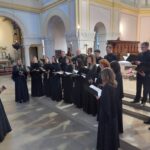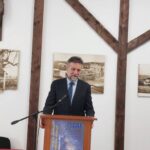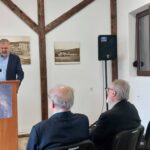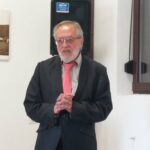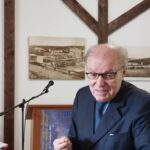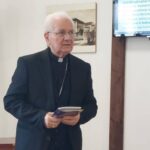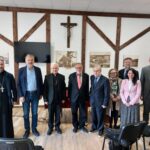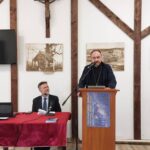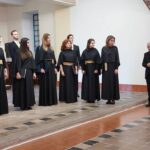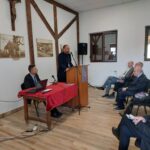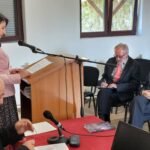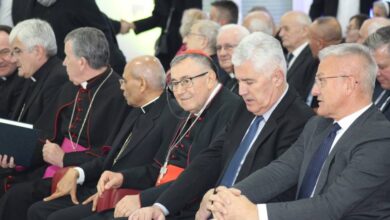SYMPOSIUM “FAITH IN GOD – UNITES OR SEPARATES?”
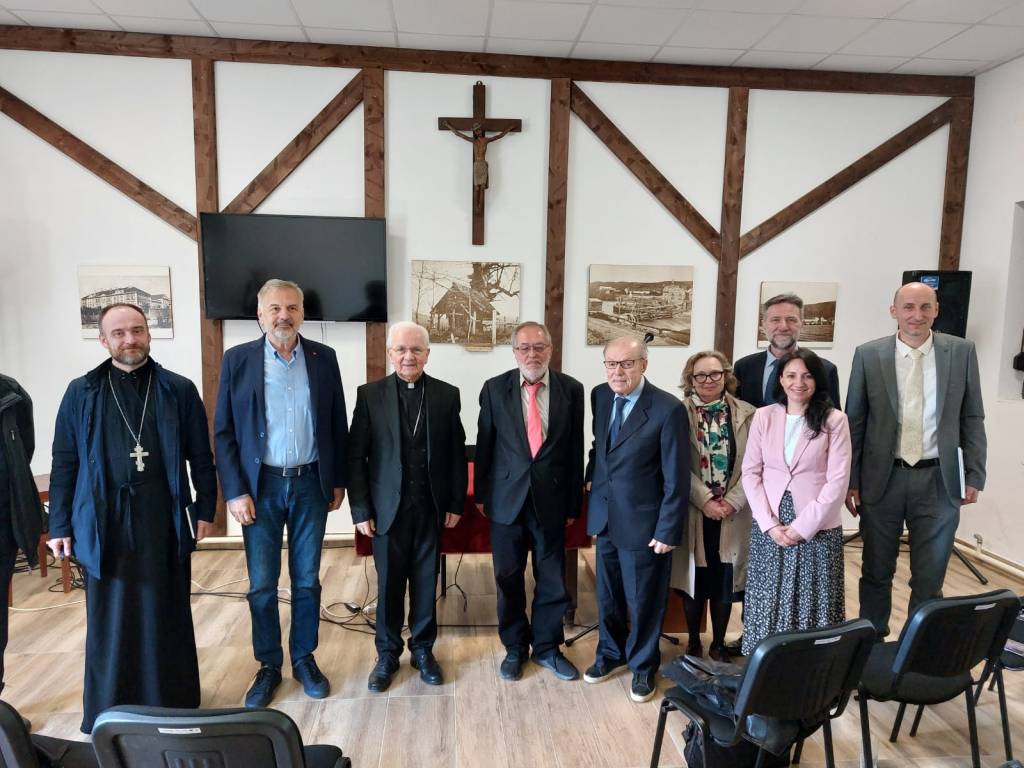
In the capitular hall of the former Trappist abbey “Marija Zvijezda” in Banja Luka, on April 22nd, a one-day scientific symposium was held on the topic “Faith in God – unites or separates?”
This, the second in a row, interdisciplinary and interconfessional Symposium on the same topic was organized by the International Academy of Sciences and Arts in Bosnia and Herzegovina, the Department of Humanities and Culture and the Department of Religions, and the European Centre for Peace and Cooperation in the Marija Zvijezda Meeting House, which was the host.
Welcome speeches
On behalf of the organizers, at the beginning of the working part of the Symposium, Asim Kurjak, president of IANUBIH, and academics Lino Veljak and Banja Luka bishop Franjo Komarica greeted those present. The Bishop, along with expressions of welcome to everyone, among other things, especially pointed out that “we are in a specific place, a century and a half long spiritual, educational, cultural and civilizational focal point, where two and a half years ago a new flame, of peace making, interreligious and interethnic cooperation within the framework of the established European Centre, started burning”.
Bishop Komarica called the participation of lecturers and others at this peace-making meeting “pouring precious oil into this desperately needed lamp”, despite the incomprehensible misunderstanding and boycott of such noble efforts by representatives of the authorities, “who should have corrected the injustice inflicted on this very deserving ancient, church institution that long ago did a lot of good to this area, the city and the people, while thinking of the restitution of the illegally confiscated property of the former Trappist abbey, where the Marija Zvijezda Meeting House is located today”. He expressed his “firm hope that things will get better in the foreseeable future.”
Prevented from participating in the Symposium in person, Francis A. Chullikatt, Apostolic Nuncio to Bosnia and Herzegovina, sent his greetings and encouragement to the participants.
Ten lecturers
This year’s symposium brought together ten authors for one day. They, each within the framework of their profession and as members of their religious community, said that faith in God is no reason for disastrous conflicts and separations, but for complementary mergers and cooperation.
Bishop Dr. Franjo Komarica spoke on the topic How can religions become capable of peacefulness?
The Bishop pointed out that there is a historical foundation for such a statement, especially in monotheistic religions such as Judaism, Christianity and Islam, because any service to idolatry and any impersonation of God are in opposition to them. This implies in practice that these religions should be considered obliged to: accept the neutral position of the state; stand up for fundamental human rights as a path to peace; to respect freedom of religious belief; to accept tolerance as a force for peace; to show in action that the use of violence is incompatible with their essential role in the human race; resolutely deny the role of martyrdom to bullies from their own ranks; resolutely and obligatorily protect oneself from abuses; overcome narrow-minded ways of thinking and cultivate ecumenism and interreligious dialogue. What should characterize them in particular is that by permanently educating their members for peace making, they themselves become capable of being valuable factors in building true peace between people and nations. Msgr. Komarica supported his claims with concrete personal experience from the time of war and post-war.
Dr. Asim Kurjak (Zagreb) spoke about the relationship between science and religion, which is of increasing interest in the world today, because throughout history these two intellectual activities, science and religion, tried to dominate or ignore each other. Today, there are more and more scientists and theologians who believe that scientific and religious truths are complementary, that they can cooperate and interact. Therefore, in his approach to the relationship between science and religion, Dr. Kurjak advocates synergism, not scepticism, supporting this approach with many examples.
Because Dr. Rusimir Mahmutćehajić (Sarajevo) could not attend the meeting, he sent his presentation. It has been read, and it was about two cognitive realities, philosophical and theological, where the author talks about God and the scientist and about the questioning of possible philosophical concepts.
Dr. Mijo Nikić (Zagreb) presented on the topic False and true images of God. The author starts from the fact that for the fruitful spiritual life of a person, for his mental health, it is necessary to have a true image of God in himself, because the faith of every person depends on the image of God that a person carries within themselves. Real images of God help a person to have a real relationship with God and to find peace and security in Him, and at the same time to be ready for an honest dialogue with others. Wrong images of God cause running away from God and rebellion against him which can cause mental disorders, exclusivity and fanaticism that separate people and can lead to conflicts and wars.
Mr. Muris Spahić (Banja Luka) spoke about the Islamic theological view on the interpretation of faith in God, starting from the fact that God can be understood as much as man can understand creation, and God is visible in everything he has created. Sticking only to the material, man is unable to separate himself from this world, and he perceives life as a biological process that is known to everyone. Such a life is without faith and remains at the level of other creatures who are not endowed with reason. Quoting the Qur’an a.š. he emphasized the interconnectedness and orientation of all who believe in the revealed God.
Dr. Vladislav Topalović (Sarajevo – Foča), spoke about Biblical antiiconism and contemporary appreciation of the visual. He pointed out that the religion of ancient Israel is extremely anti-iconic, in which the visual representation of God is strictly prohibited. The absence of an icon or cult image had great theological consequences for the further development of Judaism, Christianity and Islam and their mutual relations. As the ancient content of these three great religions, anti-iconism is today the focus of theological reflections. Today, in the era of digital technologies, which rely on visual art, the biblical and ancient oriental restraint of artistic expression of the Divine is proving more and more meaningful. Therefore, as Topalović pointed out, Christian theology today has the task of determining the boundaries of sacred art, which will clearly separate blasphemy from iconoclasm.
Žana Vukosavljević (Banja Luka), a journalist of RTV RS who has been hosting and editing religious shows on this media company for about 20 years, spoke about her experiences in the media’s approach to spirituality, religious principles and teachings preached, nurtured and inherited by the Church and religious Communities in this part of Europe. Her presentation was actually a kind of review and analysis of the previous and current situation on the interaction of representatives of Churches and religious communities with the public and viewers through broadcasts, especially in the post-war period.
Dr. Nada Gosić (Rijeka), presented on the topic Pregnancy, childbirth and religion in bioethical education in co-authorship with Tajana Tomak. She presented and updated the thoughts and viewpoints that contribute to the establishment and development of a culture of dialogue on this topic in the processes of bioethical education in order to guide medical students, future doctors, to an understanding of the basic determinants according to which pregnant women – believers live and act. The author particularly emphasized the need for the respect of religious values by medical personnel, above all doctors for a religious person, who needs to make an important life decision about pregnancy and its retention.
Dr. Dževad Zečić (Zenica), presented on the topic of the Neo-Pythagorean secret society Ihvan al-Safa from the 10th century from Basra and How an infinite multitude begins with the One. He spoke about how the aforementioned society of Neo-Pythagoreans combined the virtues of many peoples in their ideal education, being educated in Islamic, Greek, Persian, Indian, Christian and Jewish traditions, while viewing numbers through a monotheistic spiritual horizon, believing that numbers basically correspond to everything in the world and that numbers can be connected to Unity.
Dr. Pavo Barišić (Zagreb), presented on the topic Renaissance advocate of the faith that unites Juraj Dragišić from Srebrenica: defender of Bessarion, Mirandola, Savanarola and Reuchlin. He highlighted the ecumenical dimension of joining and connecting, approaching and uniting, bridging and mediating opposition and confrontation, which characterized the prominent theologian and philosopher of the Renaissance Jurjo Dragišić or Dobrotić, originally from Srebrenica in Bosnia, who achieved a magnificent university and church career at the height of the Renaissance.
The co-organizer, academic Lino Veljak and the president of the Academy, Asim Kurjak, expressed their satisfaction and gratitude for the organization and successful holding of this Symposium, as well as the belief that a similar practice will be continued in the same place in the future, to which ANU BiH will try to contribute.
Just as this one-day scientific gathering at the Meeting House “Maria Zvijezda” began with musical performance, it also ended with one. This was taken care of by the members of the Cantores Sancti Marci Oratory Choir of St. Mark from Zagreb, who held a wonderful concert of spiritual music in the parish church of Marija Zvijezda after the Holy Mass celebration.
KT


